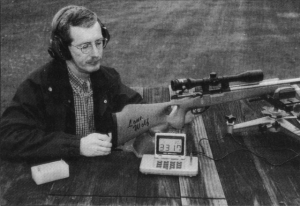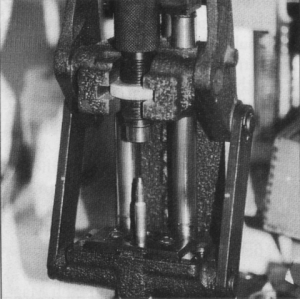|
|
|||
|
When it appeared in 1930, the Hornet was heralded as a long-range varmint cartridge. To some extent it was. Its main competitors were the .22 Long Rifle and the .25-20 Winchester (WCF). The .22 Long Rifle had a muzzle velocity around 1,250fps and the .25-20 WCF with a 60-grain bullet boasted muzzle velocities as high as 2,180 fps. With an 86-grain slug, muzzle velocity for the .25-20 WCF dropped to around 1,500 fps. Muzzle velocity for the early .22 Hornets was around 2,400 fps, and this was soon upgraded to a bit more than 2,600 fps. This was a significant increase over the Hornet's competitors, even though the .25-20 WCF cartridge was a favorite of varmint hunters in the gas light era. With all the hoopla and adoration given the new entry, the .22 Hornet was not a true long-range varmint round. In all fairness to the Hornet, long-range field shooting was probably less than 200 yards. The .22 Long Rifle cartridge had an effective field range of less than 100 yards, and the .25-20 WCF added only another 25 yards or so. Hornet admirers claimed their cartridge could easily reach 250 yards, but that was not true. A 40-grain 22-caliber bullet leaving the muzzle at more than 2,600 fps will topple a woodchuck, fox or prairie dog at 300 yards, but that doesn't mean that distance is its effective field range. Accurate bullet placement determines the effective field range, and the .22 Hornet is at its best under 200 yards. Years back, I conducted a week long series of field tests to determine the effective shooting distances for the .22 Winchester Magnum and the 5mm Remington Magnum rimfire cartridges. I started by measuring off 75 yards from a series of dens in a creek bank. Both cartridges produced instant kills. I kept moving back in increments of 10 yards, and had no problems until I reached the 125-yard mark. From that point on I missed often, and the kill ratio fell dramatically. I stopped the tests at 165 yards, for both accuracy and energy reasons. I concluded that the two rimfire magnums' effective field shooting range was about 135 yards. I'm sure many owners of either cartridge will dispute my figure as being low, but when accuracy and energy begin to wane, it's time to stop trying to reach out. Don't push a cartridge beyond its limits. The .22 Hornet was unquestionably superior to the .22 Long Rifle and the .25-20 WCF, offering up to 1,100 more fps. This was a major selling point for the .22 Hornet. Although its noise level is mild compared to the .22-250 and .220 Swift, in the gas light era, the Hornet rang out with authority. The Hornet had a strong competitor around 1938, when the .218 Bee came on the scene, and things really looked bad for the Hornet around 1940, when A. E. Mashburn improved the factory case and called it the .218 Mashburn Bee. Mashburn fire-formed the .218 Bee's factory case to a sharper shoulder angle that allowed a bit more powder and produced better ballistics. The improved Bee offered the same muzzle velocity with a 55-grain bullet as the .22 Hornet did with a 45-grain bullet. Also, the Mashburn .218 Bee had a much longer reloading life than the factory Bee or Hornet. If the Remington .222 had not entered the fray around 1950, the .22 Hornet may have been replaced by the Bee. Unfortunately for both old cartridges, the .222 sent them riding into the sunset. While the .218 Bee is slightly superior to the .22 Hornet, it is a dying cartridge. The old Hornet, for some reason, has managed to survive, but it's losing ground. I've always believed that the Hornet case (the old Winchester centerfire black powder case) with its gentle shoulder angle did not hold enough powder for 224-caliber bullets weighing more than 40 grains. Most Hornet fans stuck with the 45-grain bullet, which could be pushed to more than 2,700 fps with a maximum powder charge, according to Nosler's #4 Reloading Guide. Recently, several velocity tests were run through the new CED Millennium Chronograph with Sierra's 35-grain bullet. Muzzle velocity was slightly more than 3,000 fps. This is good news for Hornet shooters, but the new .19 Calhoon wildcat could give the old Hornet case new life. The .19 Calhoon is the brainchild of bullet maker James Calhoon of 4343 U.S. Highway 87, Havre, MT 59501. Mr. Calhoon sells several 19-caliber Re-barrel Kits. These include a match grade chambered barrel (must be threaded locally), a swaging/reloading Bonanza Forster die set, several brass brushes, 100 Calhoon bullets, and gunsmith instructions and loading data. Removing the taper and sharpening the shoulder angle by fire-forming increases powder capacity just a little more than one grain. This might not sound significant, but in a small case, one grain does make a difference, especially behind a 27-or 32-grain bullet. The fire-formed Hornet case didn't increase the powder weight by much more than one grain, but it generated about 300 fps more muzzle velocity with certain powder charges behind a 45-grain bullet. I haven't been able to obtain pressure readings or get ballistic coefficients for the .19 Calhoon, but the factory claims chamber pressures are in line with Hornet readings and ballistic coefficients are similar to .224 bullets. I described in an earlier article about building a .19 Calhoon on a Remington 591 rifle chambered for Remington's 5mm Magnum. That might surprise some readers who know that the 5mm Magnum cartridge is a rimfire and the .22 Hornet is a centerfire. There's always someone who can build a better mousetrap. Dennis Olson, Box 334, 500 First St., Plains, MT 59859 has been converting Remington 581 and 591 rimfire bolts to centerfire since 1977. Both bolts have six locking lugs, which guarantees a tighter lockup. This should be good news to owners of the discontinued Remington 591, because factory cartridges are also no longer available. It might be possible to rebarrel the 591 to a .22 Winchester Rimfire Magnum, but there would not be any real gain over the 5mm Magnum. Rebarreling the 591 to a .19 Calhoon, however, will add 140 yards to the l35-yard effective field range of either the 5mm Magnum or .22 Winchester Magnum. The rimfires boast a muzzle velocity between 2,000 and 2,100 fps; the .19 Calhoon pushes a 27-grain 19-caliber bullet at better that 3,600 fps and a 32-grain at around 3,350 fps. That's an increase of 1,350 fps with the 32-grain bullet and 1,600 with the 27-grain slug, which will transform the Model 591 into a 250-yard wood-chuck rifle. After range testing the .19 Calhoon built on the 591 action, I decided to build one on a regular .22 Hornet action. I used a USA CZ BRNO .22 Hornet action. Small and compact, the BRNO is an ideal choice for the .19 Calhoon. Jim Peightal installed a match grade chambered barrel, and Lone Wolf Adventure Gear (125 N. Hilltop Rd., Columbia Falls, MT 59912) did a super job putting the barreled action in their thumbhole Howler stock.
I topped the .19 Calhoon BRNO with a Springfield Armory 4-14x Tactical Government scope that incorporates a patented hands-free rangefinding reticle and an automatic bullet drop compensation for the 5.56mm (.223) match ammo up to 700 yards. Another nice feature is the bubble level in the scope, which is really helpful when shooting from the offhand position. The old saying, "The proof of the pudding is in the eating" could be rephrased here with "The proof of a varmint rifle is in its accuracy." While the .19 Calhoon BRNO topped with the 4-14x scope looked good, its performance on the range would quickly reveal if all my efforts had been wasted. I loaded 20 rounds of .19 Calhoon brass with 32-grain DBL HP bullets for my first range tests. CED Millennium chronograph tests printed 3,305 instrumental velocity at nine feet, which would translate into approximately 3,325 fps true muzzle velocity. I was almost finished sighting in when my son Tim arrived. I invited him to try his luck. He had seen the rifle, but had not fired it. After firing a couple of shots to get the feel of the trigger, Tim fired the first 3-shot group. It wasn't bad, but being somewhat more than an inch, it wasn't good, either. Tim's second group printed a one-holer. The third and fourth groups weren't one-holers, but they were well below an inch. The actual measurements using a Custom Products (Neil Jones) target measuring tool were: 1 5/32-inch; .220 thousandths of an inch; .550 thousandths of an inch. These groups may not be near the one-hole class, but the .19 Calhoon BRNO is not a benchrest rig. It's a varmint rifle. Also, Tim was literally a stranger to the rifle. I'm convinced this rifle will shoot under half inch 3-shot groups at 100 yards. That's top long-range varmint accuracy in anyone's book. I believe the .19 Calhoon might be more accurate at 250 yards than the Hornet is at 150. If true, it should be of great interest to Hornet fans, who will appreciate the higher velocities and longer ranges offered by the .19 Calhoon. |
||||

